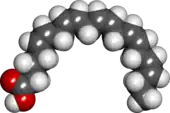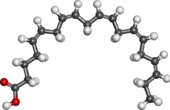花生五烯酸
花生五烯酸,也成为全顺式二十碳五烯酸(英語:)是有五個雙鍵的多元不飽和脂肪酸(C20H30O2),是一种ω-3脂肪酸。
| 二十碳五烯酸 | |||
|---|---|---|---|
| |||
| IUPAC名 (5Z,8Z,11Z,14Z,17Z)-icosa- 5,8,11,14,17-pentaenoic acid 順,順,順,順,順-5,8,11,14,17-二十碳五烯酸 | |||
| 识别 | |||
| CAS号 | 10417-94-4 | ||
| ChemSpider | 393682 | ||
| SMILES |
| ||
| InChI |
| ||
| InChIKey | JAZBEHYOTPTENJ-JLNKQSITBZ | ||
| ChEBI | 28364 | ||
| DrugBank | DB00159 | ||
| IUPHAR配体 | 3362 | ||
| 性质 | |||
| 化学式 | C20H30O2 | ||
| 302.451 g·mol⁻¹ | |||
| 若非注明,所有数据均出自标准状态(25 ℃,100 kPa)下。 | |||
来源
在人类饮食中,这种脂肪酸主要来源于食用脂肪含量高的鱼类和鱼油,例如鳕鱼肝、青鱼、鲭鱼、鲑鱼、鲱鱼、沙丁鱼和多种可食用海草和浮游植物;在人类母乳中亦存在此种脂肪酸。
但是鱼类自身并不合成EPA,而是通过食用海藻摄取[1]。人类也可通过非动物性来源获取EPA,例如微藻类。此类植物亦被培养成为一个商业化的EPA来源[2]。EPA在高大植物中不常见,但是有报道称马齿苋含微量EPA[3]。2013年曾有报道指出亚麻荠属植物的一种基因改造变种含有大量EPA[4][5]。
人体能够利用α-亚麻酸(ALA)合成自身所需的EPA。ALA是人体的一种必需脂肪酸,必须确保充足的摄入。但是,将ALA转化至EPA的效率远低于从食物中直接摄取,因为EPA本身也用于进一步合成二十二碳六烯酸(DHA)。人体很难从不含EPA和DHA的食物中间接获取足够量的EPA,因为:1.身体需要额外的代谢过程来合成EPA; 2.EPA同时又被用于合成DHA。某些疾病或者特殊条件会显著地降低身体从ALA合成EPA的能力,例如糖尿病或者一些过敏反应。
临床意义
美国国家卫生研究院的MedlinePlus数据库列出了EPA(单独使用或联合其他omega-3脂肪酸使用)能够有效治疗的疾病[6]。大多数情况下EPA被证明对发炎症状有效。
在所有omega-3脂肪酸中,EPA被认为对一些精神方面的疾病有潜在的疗效,例如精神分裂症[7][8]。
有研究表明EPA有可能对改进抑郁状态有帮助。2009年的一个综合研究发现摄取更高EPA:DHA比例的omega-3补充剂的病人较少出现抑郁症状[9]。
对人体健康的影响
对神经系统的影响
足够的脂肪酸摄入(特别是EPA和DHA)对胎儿神经系统发育成熟的重要性如今已被证明[11]。
炎症
一个研究表明鱼油(通常含有较高的EPA和DHA含量)可以通过影响多种发炎反应的机理而预防这类疾病[12]。
参考来源
- Yvonne Bishop-Weston. "Plant based sources of vegan & vegetarian Docosahexaenoic acid - DHA and Eicosapentaenoic acid EPA & Essential Fats". Retrieved 2008-08-05.
- Jess Halliday (12/01/2007). "Water 4 to introduce algae DHA/EPA as food ingredient". Retrieved 2007-02-09.
- Simopoulos, Artemis P (2002). "Omega-3 fatty acids in wild plants, nuts and seeds". Asia Pacific Journal of Clinical Nutrition 11 (Suppl 2): S163–73.
- Ruiz-Lopez, N.; Haslam, R. P.; Napier, J. A.; Sayanova, O. (January 2014). "Successful high-level accumulation of fish oil omega-3 long-chain polyunsaturated fatty acids in a transgenic oilseed crop". The Plant Journal 77 (2): 198–208.
- Coghlan, Andy (4 January 2014) "Designed plant oozes vital fish oils"' New Scientist, volume 221, issue 2950, page 12.
- NIH Medline Plus. "MedlinePlus Herbs and Supplements: Omega-3 fatty acids, fish oil, alpha-linolenic acid". Retrieved February 14, 2006.
- Peet M, Brind J, Ramchand CN, Shah S, Vankar GK (2001). "Two double-blind placebo-controlled pilot studies of eicosapentaenoic acid in the treatment of schizophrenia". Schizophrenia Research 49 (3): 243–51.
- Song C, Zhao S (Oct 2007). "Omega-3 fatty acid eicosapentaenoic acid. A new treatment for psychiatric and neurodegenerative diseases: a review of clinical investigations". Expert Opin Investig Drugs 16 (10): 1627–38.
- Martins, JG (Oct 2009). "EPA but not DHA appears to be responsible for the efficacy of omega-3 long chain polyunsaturated fatty acid supplementation in depression: evidence from a meta-analysis of randomized controlled trials.". Journal of the American College of Nutrition 28 (5): 525–42.
- Recent trends in the advanced analysis of bioactive fatty acids.Ruiz-Rodriguez A, Reglero G, Ibañez E.Departamento de Caracterización de Alimentos, Instituto de Fermentaciones Industriales, CSIC, Juan de la Cierva, 3, E-28006 Madrid, Spain.
- Ghisolfi J., 1997. Acides gras, croissance fœtale et grossesse. Arch Pediatr 1997;4 (suppl 2):133s-5s.
- Fish oil lipid emulsions and immune response: what clinicians need to know.Waitzberg DL, Torrinhas RS.Faculdade de Medicina da Universidade de São Paulo, Avenida Dr Arnaldo, 455-2 degrees andar, sala 2108, CEP: 01245-903, São Paulo, SP, Brasil; PMID 19605803 [archive] [PubMed - in process]
- Cardiovascular disease prevention and treatment.von Schacky C.Preventive Cardiology, Medizinische Clinic and Policlinic Innenstadt, University of Munich, Ziemssensstr. 1, D-80336 Munich, Germany; Omegametrix, Am Klopferspitz 19, D-82152 Martinsried, Germany. PMID 19520557 [archive] [PubMed - as supplied by publisher]
- Bagga D, Anders KH, Wang HJ, Glaspy JA. Long-chain n-3-to-n-6 polyunsaturated fatty acid ratios in breast adipose tissue from women with and without breast cancer. Nutr Cancer 42, (2002) 180-5.
- Leitzmann MF, Stampfer MJ, Michaud DS, Augustsson KA, Colditz GC, Willett WC, Giovannucci EL., 2004. Dietray intake of n-3 and n-6 fatty acids and the risk of prostate cancer. Am J Clin Nutr; 80 : 204-216.
- Courtney, E.D., Matthews, S., Finlayson,C., Di Pierro, D., Belluzzi, A., Roda, E., Kang, J.Y., and Leicester, R.J., 2007. Eicosapentaenoic acid (EPA) reduces crypt cell proliferation and increases apoptosis in normal colonic mucosa in subjects with a history of colorectal adenomas. Int. J Colorectal Dis.

